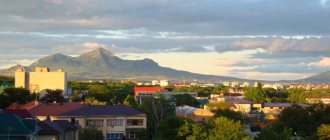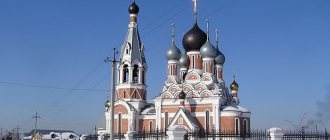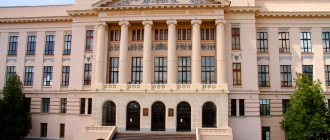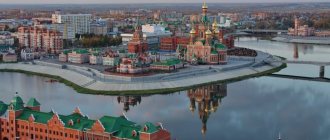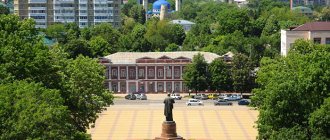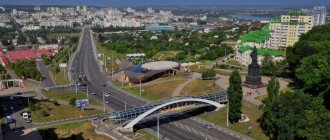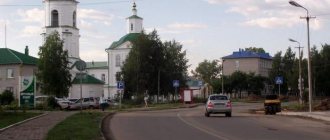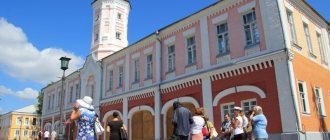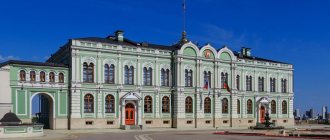Ukhta is a city located on the territory of the Komi Republic. The settlement was founded in 1929. The total area of the city is 13,200 square meters. km. The maximum altitude of the territory above sea level is 100 m. According to statistics from the 2020 census, 93,716 residents live in Ukhta.
Population growth is negative with a predominance of deaths over births. Most young people leave the city, moving closer to the western and southern regions of the Russian Federation. Ukhta is in 2nd place in terms of population among other settlements of the Komi Republic. The head of the urban settlement is Magomed Nurmagomedovich Osmanov.
About the history of Ukhta
During the times of Kievan Rus, these lands were owned by the Novgorod feudal republic. There was practically no population on them: only fur hunters. It was oil, and not oil, that for a long time was the most important strategic commodity of these places. People knew that they were rich in oil since the 15th century, but there was no need for it then. But fur was valued.
At the end of the 15th century, during the era of Ivan the Third, the territories in which present-day Ukhta is located were annexed by the Moscow Principality. In the 20s of the 16th century. The beginning of the Ukhta oil fields was laid. In 1745, with the approval of the Berg College, merchants founded the first “oil refinery” in Russian history in Ukhta.
It worked like this: oil was scooped up from the river surface and from coastal pits. Over the 20 years of the field’s existence, “as much as” 3.5 tons of oil were produced this way. In 1872-1873 The first well was drilled, from which 32 tons of oil were pumped out.
Nowadays, the old town of Ukhta is recognized as an object of historical and cultural heritage
At the beginning of the twentieth century, there were more wells. The Baltic German Alexander Georgievich Gansberg built an oil refinery (kerosene) plant and a power plant here. In 1918, the Soviet government nationalized the Ukhta oil fields.
The city of Ukhta arose on August 21, 1929, as a settlement of forced oil workers founded by the OGPU. There were 125 of them: political prisoners, criminals, dispossessed kulaks, as well as guards assigned to them, plus specialists - geologists and oil workers. At first the village was called Chibyu. New batches of prisoners were periodically sent there, for whom a 12-hour working day was established, without days off.
Oil production on an industrial scale was established in the fall of 1930. After this, roads and railways began to be built to the oil fields. In 1933, in the Ukhtpechlag of the village of Chibyu there were about 5 thousand prisoners and 206 civilian residents. The civilians lived in two-story wooden houses, the prisoners lived in barracks. In 1939, the village was renamed Ukhta.
In 1941, industrial gas production was established in this region for the first time in the history of our country. The leadership of the Komi ASSR planned at that time to move the capital of the republic from Syktyvkar to Ukhta. But with the outbreak of war, this project was postponed. Since 1943, Ukhta received official city status.
After the war, the oil and gas and processing industries, as well as the production of building materials in Ukhta began to develop at a very high pace. Pipelines were built to transport oil and gas.
Where is the city of Ukhta on the map of Russia
Ukhta is a city located in the central part of the constituent entity of the Russian Federation, the Komi Republic. The settlement is located on a hilly plateau, cut by streams and watercourses belonging to the Izhma River basin.
Ukhta, Russia
Most of the watershed areas that surround Ukhta are wetlands. Many territories are considered impassable, and movement over rough terrain is only possible with the use of special transport.
The following rivers flow in close proximity to Ukhta:
- Sedyu;
- Ukhta;
- Kedva;
- Tobys.
The territory of the city simultaneously lies on the watershed and in the delta of the Ukhta River within the boundaries of a low section of the Timan Ridge.
This locality borders the city of Sosnogorsk, as well as the following regional centers:
- Izhemsky;
- Kortkerossky;
- Knyazhpogotsky;
- Ust-Kulomsky.
The city of Ukhta is located 314 km northeast of the capital of the republic - Syktyvkar. The climatic conditions of the settlement are classified as temperate continental.
Ukhta has long, cold winters with very short, cool summers. The average annual temperature is within -1.1 °C. The weather conditions of the area must be taken into account by all travelers when planning a trip to Ukhta.
Ukhta Museum of History and Local Lore and its branches
An important historical building was chosen to house the exhibitions of this museum - one of the oldest built in Ukhta. This was the house of Ivan Ilyich Kosolapkin, a well-known personality in the city, an oil industrialist who made a significant contribution to the formation and development of this city.
The museum has been operating since 1981.
Its collections contain many wonderful exhibits on the history and ethnography of the region, as well as those that demonstrate the diversity and characteristics of the local nature. Its funds contain over 55.5 thousand exhibits of various kinds.
Thematic exhibitions that tell about the history of the city, about oil and gas production in its surroundings, about the culture and traditions of the Komi and other indigenous peoples of the North are held on an ongoing basis. A special place in the museum’s collection is occupied by those exhibits that reflect the history of the Ukhta-Pechora camp and the history of the Gulag in general.
Ukhta Museum of History and Local Lore
An important part of the institution is a special exhibition dedicated to the history of the development of the oil and gas industry in the region in the museum-apartment of a prominent geologist, honorary citizen of the city, Andrei Yakovlevich Krems. In this branch of the local history museum, operating since 1984, the furnishings of a scientist’s office are carefully preserved.
Other branches of the museum are the Museum of Geological Collection (Mira St., 5); Museum of the History of the Yarega Mines in the village of Yarega (Kosmonavtov St., 2); Museum of the History of the Vodny Village (in the Vodny Village House of Culture, Lenin St., 16)
Address: st. Mira, 5b. Office of A. Ya. Krems: on the street. Krems, 3.
Churches and temples of Ukhta
Church of the New Martyrs and Confessors of Russia who shone forth in the land of Komi
Address: st. Zeryunova, 5A Phone: 8 (2167) 6-40-01, 8 (2167) 2-44-74 Website: https://sobory.ru/article/?object=16389
Included in the complex of the Church of the Intercession of the Blessed Virgin Mary. Local residents say that the church was built on the site of the first burials, which is considered holy.
Inside there is a myrrh-streaming icon of the New Martyrs, created by the best icon painters.
Church of St. Stephen the Great
Address: st. Oktyabrskaya, 8 Phone: , 8 (247) 4-09-78 Website: https://komihram.narod.ru/pr1/index.html
The church is located in the building of the city's former cultural center. The temple consists of a library, baptism and Sunday school.
Inside are icons painted by a local school teacher.
Church of the Intercession of the Blessed Virgin Mary
Address: Zeryunova Avenue Telephone: 8 (2147) 6-40-01 Website: https://komihram.narod.ru/pr6/index.html
The temple was built thanks to the efforts of local residents. It is a two-story building, where the abbot’s office, library and school are located on the first floor, and the prayer house is located on the second floor.
Inside is an iconostasis made by prisoners.
Included in the complex of the Cathedral of New Martyrs and Confessors of Russia.
Museum of Gazprom-transgaz Ukhta LLC
This complex of exhibition halls, which began in 2003, is dedicated to the history of the development of the gas industry in the Russian North. Their total area exceeds 1500 square meters.
Museum of Gazprom-transgaz Ukhta LLC
This exhibition space features 19 permanent exhibitions operating on two exhibition grounds. The exhibitions are designed using the most modern technologies. They very clearly tell about the long history of the industry. An interesting object of the exhibition is the diorama “Shine of the North”, depicting the moment of welding the first joint of pipes on the 1st Ukhta gas pipeline with the same name as the diorama.
There are excursions adapted for children - in particular, the quest game “Travel with Northern Gas”.
Moreover, here every visitor has the opportunity to take an imaginary flight in a Mi-8 helicopter over the gas pipeline route.
Address: Lenina Ave., 50. Since August 2021, the second exhibition has also been open, at the address: emb. Gazovikov, 10/1.
How to get to Ukhta from Moscow
The city of Ukhta is surrounded by rivers and wetlands. You can get to this settlement from Moscow by plane, comfortable bus, train, or use a private car.
By plane
The distance between Ukhta and Moscow is 1251 km. By plane, this distance can be easily covered in 1.5-2 hours.
Air services between Moscow and Ukhta are provided by the following Russian airlines:
- UTair;
- S7 Airlines;
- Aeroflot.
Direct air communication between Moscow and Ukhta is carried out from several airports.
You can fly to the 2nd largest city of the Komi Republic from the following Russian air ports:
- Domodedovo;
- Zhukovsky;
- Vnukovo;
- Sheremetyevo.
Domodedovo Airport
The advantage of using this method of communication with Ukhta is that the passenger spends a minimum amount of time on the way. At the same time, the trip is as comfortable and safe as possible. The disadvantage of traveling to Ukhta by plane is the high cost of the ticket, which is 4,583 rubles, as well as the irregularity of air traffic between these cities.
The table below shows the preliminary flight schedule from Moscow to Ukhta.
| Month | Date of arrival in Ukhta | Return flight date to Moscow |
| April 2021 | April 19, 2021 | April 27, 2021 |
| May 2021 | May 01, 2021 | May 09, 2021 |
| June 2021 | June 01, 2021 | June 09, 2021 |
| July 2021 | July 01, 2021 | July 09, 2021 |
| August 2021 | August 01, 2021 | 09 August 2021 |
| September 2021 | September 01, 2021 | 09 September 2021 |
| October 2021 | October 01, 2021 | October 09, 2021 |
| November 2021 | November 01, 2021 | November 09, 2021 |
| December 2021 | December 01, 2021 | December 09, 2021 |
| January 2022 | January 01, 2022 | January 09, 2022 |
| February 2022 | February 01, 2022 | 09 February 2022 |
| March 2022 | March 01, 2022 | March 09, 2022 |
The management of aviation companies may make changes to the above flight schedule. The Ukhta airport is located on the street. Aviatsionnaya, 18. This facility is serviced by the joint-stock company Komiaviatrans JSC, which was created in 1998.
Residents and guests of Ukhta who arrived from Moscow can contact the local airport help center by calling +7 (8216) 75-61-27. Geographically, the Ukhta air port is located outside the city in the village. Further. The airport terminal operating hours are from 08-00 to 20-00.
By rail
You can get from Moscow to Ukhta by passing trains that go to Vorkuta.
In this case, it is recommended to use the following railway routes:
- Passing passenger train No. 376Ya on the Moscow-Vorkuta route. It goes through Ukhta in transit. This train arrives at the local railway station at 20-48 hours. The average stop time is 3-5 minutes. depending on the number of passengers boarding. The average ticket price is 2325 rubles.
- Branded express passenger with an increased level of comfort No. 042B. This is a fast train that passes through Ukhta only on even dates. Arrival at the railway station at 01-01 hours. Ticket price is 4328 rubles.
Yaroslavsky station in Moscow, from where the train to Vorkuta departs.
Trains traveling from Moscow through Ukhta have reserved seat and compartment passenger cars. The disadvantage of the railway connection between these two cities is that you will have to spend about 15 hours on the way. Upon arrival at the railway station, you can get to the center of Ukhta by bus with route No. 2, which departs from the station square.
Bus service
You can get from Moscow to Ukhta by a comfortable bus that departs from the Central bus station. This station is located at: Shchelkovskoye Highway, 75. The average fare is 4,468 rubles. You will have to spend about 24 hours on the way.
The advantage of using this type of transport is that during a trip from Moscow to Ukhta by bus you can see most of the regions and settlements of central Russia. The disadvantage of this method of communication is the considerable length of the journey, most of which passengers are in a sitting position.
Highways
A trip from Moscow to Ukhta by car will take at least 24 hours. This takes into account that the driver of the vehicle and his passengers will make 2-3 stops for rest and meals.
In order to get from Moscow to Ukhta by car, you must first take the Kholmogory highway and then turn onto the M-8 highway. Moving along this route, you need to get onto the P27 highway, along which you should drive another 247 km.
The advantage of traveling from Moscow to Ukhta in your own car is that all passengers have minimal dependence on other people. Travelers can take a break at any time, stay at a hotel or hostel along the route.
The disadvantage of this trip is the heavy physical and psychological stress that falls on the driver of the vehicle. The cost of travel also increases sharply. If a passenger car consumes on average 8 liters per 100 km, then at least 131 liters of fuel will have to be filled into its tank. On average it is 6266 rubles.
Museum of Liquidators of Technogenic Disasters
This museum opened in Ukhta on April 26, 2013, on the 27th anniversary of the Chernobyl nuclear power plant accident, on the initiative of a local public organization of Chernobyl liquidators. Its museum doors are always open to everyone, and primarily to schoolchildren.
Here the children are told about the essence of the Chernobyl disaster and about the work of fellow countrymen who took part in eliminating its consequences. Among the exhibits of the museum are the protective suits in which the liquidators worked, various dosimeters that measured the level of radiation, children's creative works on the theme of Chernobyl, photographs from the sites of those dramatic events and photographs of the liquidators of the accident themselves.
Museum of Liquidators of Technogenic Disasters
Educational films and videos about the accident at the Chernobyl nuclear power plant and the liquidation of the consequences of other man-made disasters in the USSR and Russia are shown.
After such an excursion, children can confidently talk about the Chernobyl accident in class and correctly answer any questions regarding this event.
Address: Kosmonavtov Ave., 19.
Museum of 20th Century Migrants
A private museum, created by a local collector-enthusiast, head of the research club, Victor Moor. The museum was based on its collection of antiques, things and household items of the first half of the twentieth century.
This extraordinary exhibition is housed in a railway carriage built in 1902. Most of the exhibits presented in the museum came from immigrants to Ukhta from other regions of Russia - hence the name.
Museum of 20th Century Migrants
In addition to the unique feeling of traveling back in time, a visit to the Museum of 20th Century Migrants gives the visitor a deep understanding of how much human life has changed over these decades, how much easier and more comfortable it has become for everyone these days.
Address: st. Bushueva, 5b.
Ukhta Folk Drama Theater
This theater is the oldest in the Komi Republic. It was founded in 1934 on the initiative of prisoners of Ukhtpechlag. Moreover, from the very beginning he was not amateur, but, one might say, professional: there were enough prisoners - artists, musicians and representatives of other creative professions in these places.
The first artistic director and director of the theater was Joseph Girnyak, a political prisoner and theater actor from Ukraine, who was imprisoned in Ukhtpechlag from 1933 to 1937. The repertoire of the “theater behind barbed wire” is impressive: J. Bizet’s opera “Carmen”, performances by M. Gorky “At the Lower Depths”, A. Ostrovsky’s “Dowry”, etc.
Ukhta Folk Drama Theater
A new creative stage of the theater began in the 50s, when an excellent Central House of Culture was built in Ukhta.
All the best in the history of this theater is associated with Vera Mikhailovna Goi, who has been its permanent director since 1974. Therefore, it is often called the “Theater of Vera Goy”. Since 1997, the “Theater for Children” has been operating at the People's Drama Theater; The traditional festival "Fun" is held.
Address: Lenin Ave., 26 (House of Culture).
Arguments against moving the capital
- It is not economically profitable. The transfer of the capital is estimated at several billion. The republic does not have that kind of money.
— Not relevant from an economic and historical point of view. Syktyvkar has been a city since 1780, and Ukhta since 1943.
— Ukhta is a more criminal city.
— Syktyvkar is more developed from a cultural point of view: there are 12 museums, 2 theaters, 5 cinemas.
— Syktyvkar is the capital of the Komi-Zyryan diasporas of all regions outside the republic.
— To maintain culture and the Komi language, it is necessary to leave Syktyvkar as the capital.
— Ukhta cannot perform representative functions.
— After the capital is moved, the population in Ukhta will increase slightly, and in Syktyvkar it will begin to decrease. Local residents will prefer to live in other regions of the country.
— It is not necessary to move the capital at all in order to develop the city. It is enough to attract investment.
— Syktyvkar is still a relevant city.
— [Due to the fact that Syktyvkar is the capital] ties between regions are being strengthened: the highway to Kirov has been repaired, and it is planned to build a similar highway to Arkhangelsk.
— Syktyvkar Airport is an international airport of federal significance. Syktyvkar airport does not always cope with large passenger traffic. It’s not a fact that Ukhta will cope with this.
“We must not forget that words about the referendum project begin with amendments to the Komi Constitution - the main law. This means a big risk for the entire statehood of the republic in a game where everyone loses in the long term,” said Lev Pruglo, a third-year student in the Political Science department.
Evgeniy Vologin
— How will moving the capital affect the Komi language and Komi culture? - asked Evgeny Vologin.
— The Finno-Ugric center is located in Syktyvkar, many congresses and events are held here. It will take a lot of effort and a lot of money. According to my personal experience, when I was in Ukhta, I did not meet a single person who spoke the Komi language,” answered Valeria Marukhno, a fourth-year student in the Journalism department.
Professor Yuri Shabaev suggested that the first thing should not be to discuss the pros and cons of Ukhta, but to find out what the population thinks about the transfer.
- What if people are wrong? - Olga Kushnir, director of the Institute of Humanities, addressed him. “They don’t count money, they are driven by populist ideas, but we have nothing else to do except discuss the transfer of the capital.”
—Are you sure that they will fall for populist ideas? - asked the professor.
- Of course they will. Judging by the way the debate was organized, it has already begun.
Monument to the Prometheans of the North
Driving along the Syktyvkar-Ukhta highway, at the entrance to the city you can see an extraordinary monument to an oil and gas industry worker. Surrounded by pipes, he lights a torch that brings warmth to the people. This monumental sculpture is dedicated to all participants in the development of local deposits and is called “Prometheans of the North”.
Monument to the Prometheans of the North
The monument was erected in November 2003. This is a bronze monument, 4 meters high, mounted on a high granite pedestal. The author of the monument was the famous sculpture from Syktyvkar A.I. Neverov. The worker’s sculpture fits well into the surrounding area and rightfully became one of the main symbols of the city of Ukhta.
Address: Lenin Ave., 50.
Monument to A.S. Pushkin
One of the main monuments in Ukhta is the monument to the great poet Alexander Sergeevich Pushkin, erected on Oktyabrskaya Square in 1999, on the eve of the 200th anniversary of the birth of the famous Russian writer.
Interestingly, this monument was a copy of another monument created by prisoners of Ukhtpechlag in 1937 to commemorate the 100th anniversary of Pushkin’s tragic death in a duel. It was made of plaster, cement, brick, and installed on a wooden pedestal. The sculpture did not have a metal frame, and it gradually collapsed over time.
Monument to A.S. Pushkin
The author of the original version, prisoner Nikolai Bruni, received a reward for his work from the camp authorities: several days of an unofficial meeting with his wife who came to see him. Just a few months after this, he was shot, having been convicted of “counter-revolutionary agitation” among prisoners. And the family was only informed many years later that he had died of pneumonia. In 1956, Bruni was posthumously rehabilitated.
The monument he created was very much loved in Ukhta and, despite its fragility, was maintained with repairs until the 1990s. And the bronze Pushkin became his copy.
Address: st. Pushkin.
A little more about the Ukhta River
But let's return to the Ukhta River . Despite its small width and smooth flow, the river periodically presented the city with surprises, especially during the spring flood.
In the 40-60s of the last century the Workers' Village , Zarechnaya , Pochtovaya , Vokzalnaya , Yuzhnaya and the floodplain of the river, where the Dynamo , always found themselves in the flood zone. For example, on May 19, 1946, a water rise of 252 cm was recorded.
In 1962, the new Neftyanik Sports Palace . They built it in the floodplain of the Ukhta River on the site of the old stadium, and it also suffered from high water.
The very next year, a dam was filled with rubble along the river, protecting it and the stadium from flooding.
Well, the largest rise in water on the river was in 1992 - 678 centimeters. That, for now, seems to be all I wanted to tell you about the Ukhta River . The story may not be very complete, but don’t judge too harshly.
Memorial to fellow countrymen-participants of the Great Patriotic War
This monument to Ukhta front-line soldiers was erected in the city in 1980. Construction completed in 1984. The memorial is made in the form of a five-pointed star inscribed in a circle with a 14-meter diameter. From its rays rise 15-meter planes, symbolizing half-mast banners.
Memorial to fellow countrymen-participants of the Great Patriotic War
These planes are united by a ring, on the inner side of which a wreath is depicted, and on the outer side - five Orders of the Patriotic War. The eternal flame stands on a base made of Karelian granite. Granite steps lead to the pedestal. On the square in front of the main monument of the memorial there are eight granite pedestals with inscriptions.
Location: in the park on the bank of the Ukhta River, at the intersection of Mira and Oktyabrskaya streets.
Monument to graduates of the Ukhta school who died in the Great Patriotic War
The monument is located in the center of the main alley of the Children's Park, on a round platform, which was formerly called “Pioneer Glory Square”. The memorial consists of bas-relief images of pioneers and soldiers of the Soviet Army, as well as battle flags bowed in grief, painted on a concrete slab. Also attached to the slab are plaques with the names of fellow countrymen who died in the war.
Monument to graduates of the Ukhta school who died in the Great Patriotic War
Location: Children's park.
Monument to the Pioneers of the North
On August 21, 1929, 125 members of the Ukhta geological exploration expedition of the OGPU, equipped in Arkhangelsk, founded the village of Chibyu - as a base settlement for exploration and production of oil and gas.
Monument to the Pioneers of the North
The memorial composition in honor of these first settlers consists of three reinforced concrete structures: a stele and two stylized drilling rigs 2.3 and 1.5 m high. On the stele there is a memorial plaque with the text: order for the Ukhta expedition No. 1 of August 21, 1929.
Location: on the left bank of the Ukhta River, opposite the buildings of the Ukhta Mechanical Plant.
The beginning of the city's history
The area around the Ukhta River, where the city will be in the future, began to be developed by people mainly thanks to oil. The settlement itself would then be named after her. This small river is a tributary of the Izhma, which in turn flows into the Pechora. It carries its waters north, to the ocean. Here, where the Ukhta (river) is located, they began to extract oil for the first time in Russia. This currently valuable mineral was found back in the 15th century, but they didn’t know how to use it then. Oil was used only for medical purposes and for lubricating mechanisms.
Mount Vetlosyan with a huge profile of Lenin at the top
A significant landmark of Ukhta is the Vetlosyan Hill, which offers a wonderful view of the entire city. The name comes from the language of the Komi people: “Vetlosyan tui” means “hunting path”. During the GULAG, there was the village of Vetlosyan, next to a woodworking plant, and there was also a first-aid post, which was initially housed simply in army-style tents.
In 1970, on the occasion of the 100th anniversary of Lenin’s birth, an original art object was placed on Mount Vetlosyan, just opposite the railway station, which became one of the main symbols of the city of Ukhta. This is a giant profile of Lenin's head 33 meters high.
Initially, the profile was illuminated at night with 120 lamps, but in the 1990s this lighting disappeared, the metal structures rusted, and the memorial sign was in danger. Only in the 2010s was it restored and the lighting was returned to it.
Mount Vetlosyan with a huge profile of Lenin at the top
It is interesting that this profile, welded from metal pipes, was an “amateur activity” of local authorities - more precisely, the first secretary of the CPSU city committee of Ukhta in 1967 -1974. Nikolai Kochurin. On a trip to the sea, he saw such an object in Batumi, on a mountain, glowing. At home, for the 100th anniversary of the leader, I decided to install the same one, but significantly larger than the Georgian one in size. Realizing that approvals were fraught with long bureaucratic red tape, he organized the installation of a memorial sign without notifying senior management.
Using metal balconies and stairs you can climb to the height of the tenth floor and explore Ukhta not just from the mountain, but also from a bird's eye view.
Intercity modes of transport in Ukhta
There are several enterprises constantly operating in Ukhta that provide intercity transport services. Depending on the travel route, guests and residents of the city can use Russian Railways buses or passenger trains.
The Ukhta bus station is located on the street. Oktyabrsk, house No. 24. The operating hours of this enterprise are from 05-00 to 21-00, seven days a week. Departure and arrival of intercity buses occurs exclusively at local time.
The Ukhta city bus station operates on the following routes:
- Ukhta - Vuktyl. The bus departs daily at 07:00, 14:00 and 18:00. The average ticket price is 849 rubles.
- Ukhta - Kazan. The flight departs daily at 09:00 and 18:00. The fare is 3,399 rubles.
- Ukhta - Kirov. The bus leaves from the bus station at 09-00 every day. The average ticket price does not exceed 2000 rubles.
- Ukhta - Sterlitamak. At 09-00 a transit flight passes through the city bus station with a stop from 2 to 5 minutes. This time is enough for passengers to load their luggage into the luggage compartment of public transport and then take their seats. At 12-00 a comfortable Mercedes bus leaves Ukhta with a direct connection to Sterlitamak. The ticket price is 4925 rubles.
- Ukhta - Syktyvkar. This direction of intercity communication is the most developed. Bus routes to the capital of the Komi Republic depart daily at 05-00, 09-00, 14-00, 18-00 and 22-00. The average fare is 894 rubles.
- Ukhta - Ufa. On Wednesdays and Sundays, the bus leaves at 05-40. There is also another daily flight on this route with intercity transport leaving at 09-00. The ticket price does not exceed 5,400 rubles.
You can get to the Ukhta bus station by public transport.
It is recommended to use the following city routes under No.:
- 1a;
- 19;
- 7;
- 12;
- 11;
- 10;
The average fare on Ukhta city buses is 24 rubles. There is a permanent information desk with a contact telephone number on the territory of the Ukhta bus station. Residents and visitors of the city can contact a transport company employee to receive information about updates and changes in the intercity service schedule.
Competition for the city bus station in terms of intercity transportation comes from the Ukhta ATP. This company provides transportation services for citizens on the route: Ukhta - Syktyvkar. The average fare for an adult is 800 rubles. one way. For children under 12 years of age, the ticket price is set at 400 rubles.
Passengers who often travel on this route have the opportunity to apply for a Unified Transport Card at the Ukhta ATP. This service will be relevant for city guests who travel in large groups.
ATP of the city of Ukhta is located on the street. Zapadnaya, house no. 8.
All information regarding intercity flights of this company can be obtained by calling:
- +7;
- 8 (8216) 740-200.
Passengers are transported by modern and comfortable PAZ buses, as well as Mercedes Sprinter. The Ukhta automobile company provides bus rental services for individual intercity trips.
For example, for transporting large and medium-sized tourist groups between populated areas and natural attractions of the Komi Republic.
The city of Ukhta is located in a region whose climate is equal to the conditions of the Far North. The soil here freezes to a depth of 2 m. Despite this, several passenger and freight railway lines are constantly operating in the city.
The railway station in Ukhta is located on the street. Vokzalnaya, building No. 1. Rail transport is considered one of the fastest, safest and most comfortable methods of intercity communication. The railway station is located at a distance of over 2500 m from the city center, and is also separated from the main part of Ukhta by a river.
Residents and guests of Ukhta who need to get to the railway station can use the services of bus route No. 2 (departure from Kuratova Street, travel through the central streets to the railway station). The average fare is 24 rubles.
People who want to save on public transport can go to the train station on foot. On average, the path from the city center to the street. Vokzalnaya, 1 will take from 30 to 40 minutes. This takes into account that the person will walk at an average pace.
The table below shows the schedule of railway transport routes, with the help of which residents and guests of Ukhta can use intercity services.
| Railway route | Departure time | Arrival time | Days of the week |
| Nizhny Novgorod — Vorkuta | 17-48 | 17-38 | Transit train No. 090G through Ukhta runs daily. |
| St. Petersburg — Vorkuta | 19-04 | 18-49 | Passing express train No. 078Ya moves through Ukhta every day. |
| Moscow — Vorkuta | 20-48 | 20-31 | Transit train No. 376Ya daily. Tickets for this route must be purchased in advance, as they are always in demand. |
| Moscow — Vorkuta | 01-01 | 00-51 | Branded express No. 042B, which passes through Ukhta on even dates. |
| Usinsk — Syktyvkar | 01-27 | 01-16 | Transit route with daily movement of passenger train No. 305Ya. |
| Labytnangi — Moscow | 01-47 | 01-37 | Intercity transport services are provided by. Train No. 021Н runs daily. |
| Vorkuta — Adler | 02-57 | 02-47 | Passing passenger train No. 309С, which passes through Ukhta daily. |
| Syktyvkar — Usinsk | 03-27 | 03-07 | Transit express No. 306Ya with daily service. |
| Vorkuta — Moscow | 06-32 | 06-22 | Branded passenger train No. 041M with an increased level of comfort passes through Ukhta every day. |
| Usinsk — Syktyvkar | 12-53 | 12-48 | Daytime express No. 053Ya, which provides Ukhta residents with daily intercity service. |
| Adler — Vorkuta | 16-52 | 16-42 | Passing train No. 310E, which runs daily, connecting the southern and northern regions of the Russian Federation. |
| Moscow — Vorkuta | 01-01 | 00-51 | Branded long-distance express No. 042B, which passes through Ukhta on odd dates. |
| Usinsk — Syktyvkar | 01-27 | 01-16 | Passenger train No. 305Ya moves through Ukhta in transit every day. Average parking duration is 5 minutes. |
| Syktyvkar — Usinsk | 03-27 | 03-07 | Passing train No. 306Ya with daily service. |
Using railway transport, Ukhta residents and city guests have the opportunity to get to almost any region of the Russian Federation with a minimum number of transfers.
Eshmes Cave
This cave is a unique historical and archaeological monument. This is an ancient sanctuary of the indigenous peoples of the region, in which pagan rituals were performed.
Eshmes Cave
During the research and excavations, scientists found ancient artifacts in it that tell about the lifestyle, customs and way of life of the local population. Including spear tips, animal bones and teeth. As well as 35 different items made of silver and bronze: pendants and plates, 1 image of the Permian animal style, 2 silver coins - the first Iranian from the mid-10th century, the second from the German early 11th century. The most valuable finds were recognized as two idols, which were deposited in the local history museums of Ukhta and Syktyvkar.
Location: tributary of the river. White Ashmess.
Camp times
The infamous Ukhtpechlag is associated with Ukhta. The Ukhta-Pechora camp included a huge territory of 1.5 million km2 with its center in Ukhta. What a vast area, and yet everything is dedicated to prison! It also included the upper and middle reaches of the Vychegda and the Pechora basin. The camps also captured the Timan Ridge. If you look on old maps of Russia to find out what region Ukhta is in, then on them it was listed as the Autonomous Region of Komi. Today it is not part of the region, but of another subject of the Federation - the Komi Republic.
The Ukhtpechlag administration was located in Chibyu (present-day Ukhta). Since 1931 it has been one of the Gulag prison centers. More and more prisoners were brought here along the highway.
The barracks were overcrowded; according to data, there were about two thousand people here. In 1929, a mechanical repair plant opened here. It was thanks to the repressed that the village began its intensive development, and the development of the north took place. The prisoners had a lot of hard and life-threatening work; not everyone lived to see their release. They mined coal, obtained radium from local radioactive waters in laboratories, and significantly increased the volume of oil produced. The world's only oil mine was built in the upper reaches of the Yarega River, where they began to extract heavy oil. A vocational school was even organized, where the necessary specialists were trained from prisoners.
Nature reserves "Belaya Kedva", "Sedyuksky", "Chutinsky"
A number of nature reserves have been created in the Komi Republic. In the vicinity of the city of Ukhta there are also beautiful protected areas that are local natural attractions. They carefully preserve the beauty of nature in its original form. Of great interest are the rivers and forests, the unique landscape, and rare species of flora and fauna of the local region.
In the Belaya Kedva reserve
First settlement
For the first time, the village of Chibyu appeared on the site where the city of Ukhta is located, which happened after the revolution, in 1929. This was the first full-fledged settlement. Since 1933, Chibyu became the center of Ukhtpechlag (one of the centers of the Gulag). An unfavorable and difficult time for people, but it gave development to the village. In addition, thanks to its location in the very center of the Komi Republic, Chibyu grew and developed. Soon a new name appeared - Ukhta. At one time they even wanted to make this urban-type settlement the administrative center of the region, but all plans were confused by the war. At the same time, Ukhta received city status.
